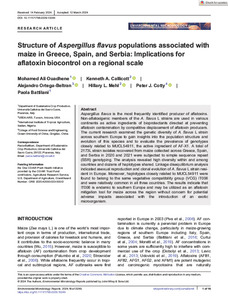| dc.contributor.author | Ouadhene, M.A. |
| dc.contributor.author | Callicott, K. |
| dc.contributor.author | Ortega-Beltran, A. |
| dc.contributor.author | Mehl, H.L. |
| dc.contributor.author | Cotty, P.J. |
| dc.contributor.author | Battilani, P. |
| dc.date.accessioned | 2024-06-03T09:14:31Z |
| dc.date.available | 2024-06-03T09:14:31Z |
| dc.date.issued | 2024-04 |
| dc.identifier.citation | Ouadhene, M.A., Callicott, K., Ortega‐Beltran, A., Mehl, H.L., Cotty, P.J. & Battilani, P. (2024). Structure of Aspergillus flavus populations associated with maize in Greece, Spain, and Serbia: implications for aflatoxin biocontrol on a regional scale. Environmental Microbiology Reports, 16(2): e13249, 1-16. |
| dc.identifier.issn | 1758-2229 |
| dc.identifier.uri | https://hdl.handle.net/20.500.12478/8492 |
| dc.description.abstract | Aspergillus flavus is the most frequently identified producer of aflatoxins. Non-aflatoxigenic members of the A. flavus L strains are used in various continents as active ingredients of bioprotectants directed at preventing aflatoxin contamination by competitive displacement of aflatoxin producers. The current research examined the genetic diversity of A. flavus L strain across southern Europe to gain insights into the population structure and evolution of this species and to evaluate the prevalence of genotypes closely related to MUCL54911, the active ingredient of AF-X1. A total of 2173L strain isolates recovered from maize collected across Greece, Spain, and Serbia in 2020 and 2021 were subjected to simple sequence repeat (SSR) genotyping. The analysis revealed high diversity within and among countries and dozens of haplotypes shared. Linkage disequilibrium analysis indicated asexual reproduction and clonal evolution of A. flavus L strain resident in Europe. Moreover, haplotypes closely related to MUCL54911 were found to belong to the same vegetative compatibility group (VCG) IT006 and were relatively common in all three countries. The results indicate that IT006 is endemic to southern Europe and may be utilized as an aflatoxin mitigation tool for maize across the region without concern for potential adverse impacts associated with the introduction of an exotic microorganism. |
| dc.description.sponsorship | CGIAR Trust Fund |
| dc.description.sponsorship | United States Department of Agriculture |
| dc.format.extent | 1-16 |
| dc.language.iso | en |
| dc.subject | Aspergillus Flavus |
| dc.subject | Maize |
| dc.subject | Aflatoxins |
| dc.subject | Biological Control |
| dc.subject | Food Security |
| dc.title | Structure of Aspergillus flavus populations associated with maize in Greece, Spain, and Serbia: implications for aflatoxin biocontrol on a regional scale |
| dc.type | Journal Article |
| cg.contributor.crp | Agriculture for Nutrition and Health |
| cg.contributor.affiliation | Università Cattolica del Sacro Cuore |
| cg.contributor.affiliation | United States Department of Agriculture |
| cg.contributor.affiliation | International Institute of Tropical Agriculture |
| cg.contributor.affiliation | Ocean University of China |
| cg.coverage.region | Europe |
| cg.coverage.country | Greece |
| cg.coverage.country | Serbia |
| cg.coverage.country | Spain |
| cg.coverage.hub | Headquarters and Western Africa Hub |
| cg.researchtheme | Plant Production and Health |
| cg.identifier.bibtexciteid | OUADHENE:2024 |
| cg.isijournal | ISI Journal |
| cg.authorship.types | CGIAR and developing country institute |
| cg.iitasubject | Aflatoxin |
| cg.iitasubject | Agronomy |
| cg.iitasubject | Disease Control |
| cg.iitasubject | Food Security |
| cg.iitasubject | Maize |
| cg.journal | Environmental Microbiology Reports |
| cg.notes | Open Access Article |
| cg.accessibilitystatus | Open Access |
| cg.reviewstatus | Peer Review |
| cg.usagerightslicense | Creative Commons Attribution 4.0 (CC BY 0.0) |
| cg.targetaudience | Scientists |
| cg.identifier.doi | https://doi.org/10.1111/1758-2229.13249 |
| cg.iitaauthor.identifier | Alejandro Ortega-Beltran: 0000-0003-3747-8094 |
| cg.futureupdate.required | No |
| cg.identifier.issue | 2: e13249 |
| cg.identifier.volume | 16 |

